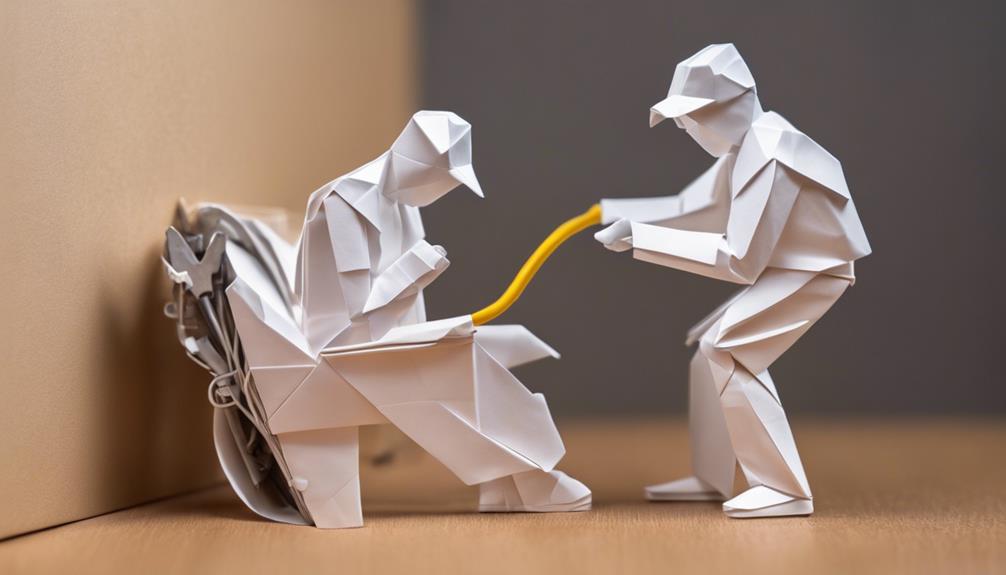When embarking on home renovations or DIY projects, it's crucial to remember the ancient saying, "Where there's smoke, there's fire." Ensuring your safety and that of your loved ones should be the top priority as you make improvements to your living space. By following a few key fire safety tips, you can significantly reduce the risk of potential hazards. Remember, a little precaution can go a long way in safeguarding your home and family from the unexpected.
Electrical System Updates

When renovating your home, it is crucial to regularly inspect and update the electrical system to ensure safety and functionality. Start by conducting a thorough wiring inspection to check for any wear and tear, exposed wires, or outdated components. This step is essential in preventing potential fire hazards and ensuring that your electrical system is up to code.
As you proceed with the wiring inspection, remember to follow safety precautions. Always turn off the power to the area you are inspecting to avoid the risk of electric shock. Use appropriate tools and equipment, such as voltage testers, to ensure that circuits are not live before touching any wires. Additionally, wear insulated gloves and eye protection to protect yourself during the inspection process.
Proper Storage of Flammable Materials
To ensure maximum safety during your home renovations, it is essential to properly store flammable materials in designated areas away from potential ignition sources. When storing these materials, consider the following tips:
- Ventilation Requirements: It is crucial to store flammable materials in well-ventilated areas to prevent the accumulation of flammable vapors. Ensure that the storage space has proper airflow to reduce the risk of fire hazards.
- Fire Resistant Containers: Use fire-resistant containers to store flammable materials safely. These containers are designed to withstand high temperatures and reduce the risk of fire spreading in case of an accident. Invest in quality containers to minimize fire hazards.
- Proper Labeling: Always label flammable materials correctly to ensure that everyone in the household is aware of the contents. Clear labeling can help prevent accidents and ensure that the materials are handled with caution. Be meticulous in marking containers to avoid confusion and mishandling.
Safe Use of Power Tools

Ensuring the safe use of power tools is paramount during home renovations and DIY projects to prevent accidents and injuries. Proper tool maintenance is crucial for safe operation. Before using any power tool, conduct a thorough risk assessment. Check for any damage, frayed cords, or malfunctioning parts that could pose a safety hazard. Always follow the manufacturer's instructions for usage and safety guidelines.
When operating power tools, take necessary precautions to minimize risks. Wear appropriate personal protective equipment such as safety goggles, gloves, and ear protection. Ensure that the work area is well-lit and free from clutter to prevent tripping hazards. Keep tools unplugged when not in use and store them in a secure place out of reach of children.
Remember to never force a tool or use it for a task it's not designed for. Stay focused, avoid distractions, and work at a pace that allows you to maintain control over the tool. By practicing tool maintenance and following safety protocols, you can significantly reduce the likelihood of accidents while using power tools in your home projects.
Installation of Smoke Alarms
When installing smoke alarms in your home, remember to place them on every level, inside bedrooms, and near sleeping areas for maximum coverage. It is crucial to conduct regular maintenance checks by testing the alarms monthly, replacing batteries annually, and replacing the entire unit every ten years. Proper placement and upkeep of smoke alarms are essential to ensure early detection of fires and protect your household.
Proper Alarm Placement
Make sure you position your smoke alarms strategically throughout your home to maximize their effectiveness in detecting fires. Here's how to ensure proper alarm placement:
- Install at least one smoke alarm on every level of your home to provide comprehensive coverage. Place them near bedrooms and common areas.
- Interconnect your smoke alarms so that when one alarm detects smoke, all alarms will sound. This ensures everyone in the house is alerted.
- Mount smoke alarms on ceilings or high on walls following manufacturer recommendations. Avoid corners and areas near vents that could affect smoke detection.
Regular Maintenance Checks
To maintain the effectiveness of your smoke alarms, it is essential to conduct regular maintenance checks, ensuring that they are properly installed and functioning correctly. Inspection reminders can help you stay on top of this crucial task. Start by testing each alarm monthly by pressing the test button. Additionally, every six months, use a vacuum to clean the alarms and remove any dust or debris that could interfere with their operation. It's also important to replace the batteries in your smoke alarms at least once a year or according to the manufacturer's recommendations. Following these maintenance schedules is vital to prevent fire hazards and ensure your smoke alarms are ready to alert you in case of an emergency.
Maintenance of Fire Extinguishers

Regular maintenance of fire extinguishers is essential to ensure their functionality during emergencies. Here are three crucial steps to keep your fire extinguishers in top shape:
- Regular Inspection and Replacement: Conduct routine checks to ensure the extinguisher is not damaged or compromised. Check the pressure gauge, seals, and overall condition. If any issues are detected, replace the extinguisher promptly to guarantee its effectiveness in case of a fire.
- Proper Placement and Accessibility: Store fire extinguishers in easily accessible locations, visible and reachable in case of a fire. Avoid placing them behind furniture or in cluttered areas. Ideally, mount them on walls at a convenient height. Ensure that everyone in your household knows where the extinguishers are located.
- Professional Maintenance: Schedule professional maintenance at least once a year. Certified technicians can inspect, service, and recharge your extinguishers to keep them in optimal working condition. This ensures that your extinguishers are ready to use when needed most.
Fire Escape Planning
When it comes to fire escape planning, it is crucial to plan multiple exits and practice evacuation drills regularly. Make sure all family members are aware of the escape routes and where to meet outside. Having a well-thought-out plan can save lives in case of an emergency.
Plan Multiple Exits
Consider creating a detailed floor plan that clearly indicates all possible exits in case of a fire emergency during your home renovations or DIY projects. This step is crucial for emergency preparedness. When planning multiple exits, ensure they are easily accessible and not blocked by furniture or equipment. Here are important points to keep in mind:
- Identify Primary and Secondary Exits: Have a primary exit route and a backup secondary route to evacuate safely.
- Ensure Windows are Accessible: Check that windows can be easily opened for emergency escape.
- Practice Using Each Exit: Familiarize yourself and your household members with all possible exits to ensure a smooth evacuation process.
Practice Evacuation Drills
To enhance your preparedness for a fire emergency during home renovations or DIY projects, it is vital to conduct regular evacuation drills as part of your fire escape planning. Start by mapping out the evacuation route from each room in your home. Ensure that everyone in your household knows the primary and alternative exits to use in case of a fire. Practice these drills regularly, especially if the layout of your home changes during renovations. Designate a family meeting spot a safe distance away from your home where everyone should gather after evacuating. This spot ensures that all family members are safe and accounted for. By practicing evacuation drills, you can react quickly and efficiently during a fire emergency, potentially saving lives.
Supervision of Open Flames

Ensure open flames are continuously monitored during home renovations and DIY projects to prevent potential fire hazards. Whether you are enjoying a cozy evening by a fire pit or adding ambiance with candles indoors, it's crucial to keep a watchful eye on open flames to protect your home and loved ones. Here are key tips to help you supervise open flames effectively:
- Fire Pit Safety: When using a fire pit for outdoor cooking or entertainment, never leave it unattended. Keep a fire extinguisher nearby and ensure the fire is completely extinguished before leaving.
- Candle Precautions: Indoors, always place candles on stable surfaces away from flammable materials. Never leave candles burning in unoccupied rooms, and consider using flameless options for added safety.
- Continuous Monitoring: Regularly check on any open flames, ensuring they are properly contained and controlled. Don't let distractions divert your attention from the potential fire risks posed by open flames. Stay vigilant to prevent accidents.
Frequently Asked Questions
Can Fire Safety Hazards Increase During Home Renovations and DIY Projects?
When tackling home renovations or DIY projects, fire safety hazards can indeed increase. It's crucial to be aware of potential risks and take necessary precautions. Conduct a thorough risk assessment before starting any work. Implement proper safety measures like having fire extinguishers nearby and ensuring smoke detectors are working. Mitigate risks by keeping flammable materials away from heat sources and following proper electrical safety guidelines. Prevention is key to avoiding fire incidents during renovations.
How Can I Ensure That My Home Is Adequately Equipped With Smoke Alarms During a Renovation?
When ensuring your home is equipped with smoke alarms during a renovation, consider placing them strategically on each level and inside sleeping areas. Regularly check and maintain these alarms to guarantee they function correctly. Install fire safety equipment like fire extinguishers in key locations. Be vigilant in adhering to installation guidelines for optimal protection. Stay safe by being proactive in fire prevention measures throughout your home renovation process.
Are There Specific Guidelines for Storing Flammable Materials During a Renovation?
When storing flammable materials during a renovation, it's crucial to follow specific guidelines to ensure safety. Proper ventilation is key to reducing the risk of fire hazards. Always store flammable items in designated areas away from heat sources and open flames. Implement safety protocols when handling hazardous materials to prevent accidents. By adhering to these guidelines, you can create a safer environment for yourself and others during the renovation process.
What Precautions Should Be Taken When Using Power Tools in a Home Renovation Project?
When using power tools for your home renovation project, safety precautions are vital. Always wear appropriate safety gear like goggles and gloves. Make sure to inspect tools for any damage before use, and follow manufacturer guidelines for maintenance. Keep cords away from water and sharp edges to avoid accidents. It's crucial to unplug tools when not in use and store them in a secure location. Prioritize safety to prevent injuries during your renovation.
How Often Should Fire Extinguishers Be Checked and Maintained During a Renovation or DIY Project?
When tackling a renovation, it's crucial to keep safety at the forefront. Regularly check your fire extinguishers to ensure they are in good condition. Maintenance should be done at least once a year, or more frequently if needed. This small step can make a big difference in preventing fire risks during your DIY projects. Stay proactive and prepared to handle any potential emergencies that may arise. Your safety matters most.



